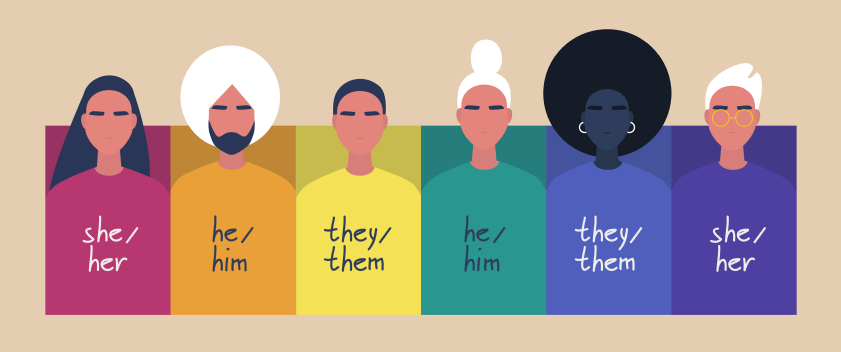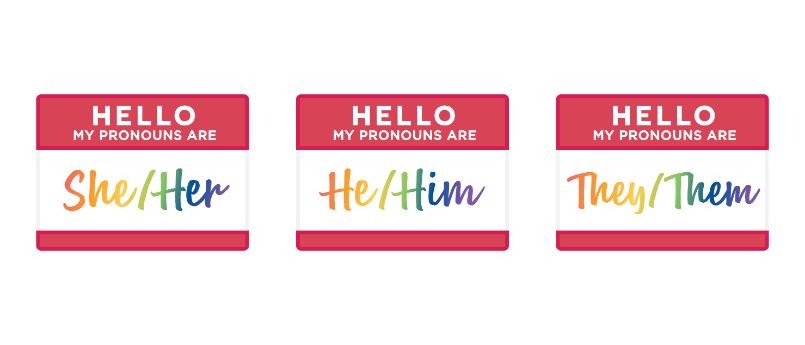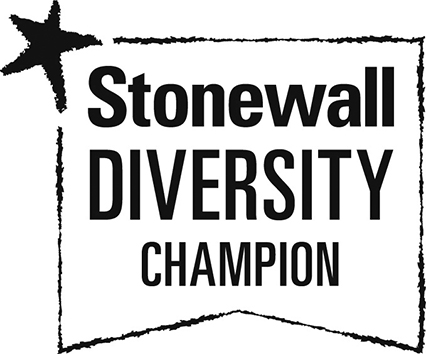Gender Reassignment
Gender reassignment is a way of describing a person’s transition or their intention to transition. These are the steps a trans or non-binary person may take to live in the gender with which they identify, and these steps are different for everybody.
Gender reassignment refers to a person proposing to undergo, undergoing, or having undergone a process to reassign the sex they were assigned at birth. Gender reassignment is a protected characteristic under the 2010 Equality Act. To be protected from discrimination, a person does not need to have undergone any medical treatment or surgery to change from their birth sex to their gender identity. They can be at any stage in the transition process and do not need to have applied for or obtained a Gender Recognition Certificate, which is the document that confirms the change of a person's legal sex.
Gender affirmation is another way of describing a person's transition or their intention to transition. Whilst 'gender reassignment' is the terminology used in the Equality Act 2010, the university's Rainbow network for LGBTQ+ colleagues prefers the term gender affirmation. This is because gender affirmation is a more inclusive term and one that the LGBTQ+ community at Newcastle would like the wider NU community to support. Gender reassignment is a legal term in the Equality Act 2010 and must be used when writing legal documents, such as an Equality Analysis document.
Let’s talk about gender reassignment
The Equality Act
Gender reassignment is one of nine protected characteristics under the Equality Act. Under the Equality Act 2010, gender reassignment refers to individuals who have undergone, intend to undergo or are currently undergoing medical and surgical treatments to alter the body, as well as those who do not intend to undergo medical treatment. Gender reassignment is a personal process, rather than a medical one.
What is gender reassignment?
Gender reassignment is a way of describing a person’s transition or their intention to transition. These are the steps a trans or non-binary person may take to live in the gender with which they identify. Each person’s transition will involve different things. For some this involves medical intervention, such as hormone therapy and surgeries, but not all trans people want or are able to have this. Transitioning also might involve things such as changing names, pronouns, living in their self-identified gender, telling friends and family, dressing differently and changing official documents. There is not an equivalent or similar pathway for non-binary individuals, so not all individuals can do this.
‘Trans’ and ‘transgender’ are used as inclusive ‘umbrella’ terms for anyone whose gender identity and/or gender expression differs from the sex they were assigned at birth. You can find out more about terms that are commonly used and how to be mindful in the language you use in the Inclusive Language Section. Stonewall have also collated a list of LGBTQ+ terms.
It is also important to be aware that if someone is transgender, this may not reflect their sexual orientation, so it is best not to make assumptions. It is important to remember that gender and sexuality are separate constructs – you can check out a video that explains the difference between gender, sex and sexual orientation. Non-binary is an umbrella term for people whose gender identity doesn’t sit comfortably with ‘man’ or ‘woman’. Non-binary identities are varied and can include people who identify with some aspects of binary identities, while others reject them entirely.
What are pronouns and why do they matter?
Pronouns are how we refer to ourselves or others. They include you, we, I, it, she, he, and they. Gendered pronouns such as ‘he’ or ‘she’ are how we refer to people’s gender in conversation. Some people may prefer others to refer to them in gender neutral language and use pronouns such as they/their and ze/zir. A person’s pronouns are not always obvious and will depend on how they identify and cannot be assumed based on a person’s appearance or name.
Using someone’s correct personal pronouns is important and helps to create an inclusive environment. When someone asks you to use a certain pronoun, using it shows that you respect them and their identity, just like pronouncing a person’s name correctly is respectful. It makes people feel more comfortable and more able to contribute. Using the wrong pronoun can be hurtful to individuals as it can invalidate a person’s identity – take care and consideration when using pronouns.
You can check out this short video which explains the importance of pronouns and why they matter to people. There is a section at the end of this page on the use of pronouns which you might also find helpful.

Gender reassignment and discrimination
Impact of transphobia
Gender reassignment discrimination occurs when someone is treated differently because they have reassigned their sex, are in the process of reassigning their sex, or are planning to reassign their sex. Transgender people may experience harassment and discrimination from people who are uncomfortable with these identities. Transphobia is the fear, hatred, disbelief or mistrust of people who are transgender, thought to be transgender, or whose gender expression doesn’t conform to traditional gender roles. Transphobia can involve invasive questions, name-calling, deliberate misgendering, irrational fear and misunderstanding, bullying and violence. You can find more information on transphobia online.
Transphobia is a societal problem, and hate crimes are disproportionally on the rise. A survey and report in 2020 found that in the previous 12 months, 4 out of 5 respondents had experienced a form of transphobic hate crime, and nearly 1 in 5 had experienced transphobic sexual assault or the threat of sexual assault. As one can readily envisage, the impact of transphobia is devastating. Discrimination and violence, the energy that a transgender person must use to protect themselves against violence and discrimination, and the internalisation of negative stereotypes contribute towards mental health conditions. Self-reported levels of mental health conditions are very high.
Transphobia can have an impact on other aspects of a transgender individual’s life, such as confidence in applying for jobs and effects on finances. This article highlights the reality of a transgender person who feels they live in a transphobic society.
The impact of misgendering
Misgendering happens when you intentionally, or unintentionally, use language to describe a person that doesn’t align with their gender identity. For example, referring to a woman as “he”, or calling her a “guy” is misgendering. You can check out our Inclusive Language Guide for the definition of ‘gender identity’. Being misgendered can create a range of emotions for the individual from sadness to anger. Having someone either intentionally or unintentionally misgender you can make you feel invisible. When this happens to an individual on a daily basis it can really take its toll on a person’s confidence and self-worth.
The impact of deadnaming
A ‘deadname’ is the name that transgender people no longer use once they transition. For many people who are transgender, undergoing a name change can be an important step in their transition process and changing their gender identity.
When you refer to a person who is transgender by their deadname, it is disrespectful and can be distressing. Names are a huge part of our identity. Transgender people risk being ‘outed’ every time their deadname is used. They may not wish to share that they are transgender. When they correct the use of their deadname, they are coming out as transgender, which can be stressful. Individuals who identify as non-binary may also change their name to reflect their identity. It’s important that you use the name and pronouns that an individual asks you to use.
Access to facilities
Many transgender and non-binary individuals report that gendered spaces, such as bathrooms and changing rooms, can be troubling places for them. They can also be intimidating places where transgender people can feel vulnerable and can fear verbal and physical abuse. Gender-neutral toilets are becoming widespread on university campuses. The installation of gender-neutral toilets, washing and changing facilities is beneficial to trans people, particularly non-binary individuals. It is good practice to find out what gender-neutral facilities are available to support colleagues, students and visitors working with them. Transgender and non-binary people should be supported by being able to use the toilet facilities that they believe they will be safest in.

Gender reassignment in academia and research
Understanding the experiences of transgender colleagues and students in higher education
Many trans students experience discrimination and harassment, which can affect their academic success and whether they stay in academia or related research careers. A recent study on the experiences of transgender scientists suggested that nearly half of those who said they were transgender had considered leaving their workplace because of the climate towards LGBTQ+ people, with 20% of them considering this often. To create a climate where researchers can flourish, transgender people need to feel comfortable in their workplace. Students and colleagues may rely on senior colleagues as important sources of support, so it is important to grow your understanding.
You can watch a video of Professor Deirdre McCloskey and read an article by Tanja Junkers to hear about their experiences in academia as transgender women. Advanced HE have produced guidance on improving the experiences of trans colleagues and students in Higher Education.
Misgendering in academia
Transgender and non-binary students and colleagues are often misgendered in their day-to-day interactions. A qualitative study exploring the impact of being misgendered found that students have reported feeling stressed and uncomfortable when being misgendered, and it breaks the flow of the conversation, leaving people feeling awkward. It can be difficult for people to correct others when they are misgendered, particularly by more senior researchers. Postgraduate researchers felt that they could not correct their supervisors, as they feared it could jeopardise future career opportunities.
It is important to find out what an individual’s pronouns are (e.g. he/his, she/her, they/their), so that they are never misgendered. As a leader in research, you can correct other team members and colleagues if mistakes are made, to help ensure everyone feels respected and valued. You can read more about pronouns and why they matter in our section on pronouns at the end of this page.
Deadnaming in academia
Changing names on colleague and student ID cards, email addresses and university systems can be a challenge. It is important to help students and colleagues make these changes, and find out how they can be supported by your university.
The career paths of transgender researchers can be impacted by name changes once they transition. For example, their deadname may be on their past published papers, which can be difficult or impossible to change. To avoid drawing attention to their name change and being outed, transgender researchers may not include publications that carry their deadname on their CVs or link them to their ORCID number. Calls for publishers to be trans-inclusive have led to some journals developing policies to allow researchers to change their names on publications whilst protecting their right to privacy. You can check out a blog post on the changes at Wellcome Open Research, which is the first journal to develop and adopt such a policy. As a leader in research, you can provide valuable support for students and colleagues seeking to change their name on past publications, and potentially use positions of influence with journals to advocate for change.
Collecting data around gender reassignment
Collecting research data on gender, sexual orientation and sex
Billie Moffat-Knox from the School of Psychology has collated some information around inclusive language and appropriate response options for collecting data about participants’ gender, sexual orientation, sex (if relevant), ethnicity and disability/neurodiversity/health conditions. Collecting and reporting this data improves the representation of individuals within scientific research.
Below are some examples of how to ask participants what their gender, sexual orientation and sex are.
What is your gender*? (Where Cisgender means that you identify with the sex you were assigned at birth, i.e. with the sex on your birth certificate)
- Cisgender Woman
- Trans Woman
- Cisgender Man
- Trans Man
- Non-binary
- Self-describe: [open text-entry box]
- Prefer not to say
What is your sexual orientation*?
- Asexual
- Bisexual
- Gay
- Heterosexual/Straight
- Lesbian
- Pansexual
- Queer
- Self-describe: [open text-entry box]
- Prefer not to say
*The most inclusive option for questions about both gender and sexual orientation would be to give an open text box instead of a list of options. For example, there are ~40 sexual orientations because there are multiple gender identities and thus multiple intersections of attraction. However, this is challenging for data collation and analysis, and participants often write ambiguous or problematic responses, such as ‘normal’ or ‘natural’. Providing a list such as the above using inclusive language is considered a fair compromise.
Note: We should only ask participants about their sex if this is pertinent to the research.
What is your sex (assigned at birth)?
- Female
- Male
- Intersex [optional text-entry box to self-describe could be provided]
- Prefer not to say
What actions can you take?
What actions can we all take as researchers, research enablers or leaders in research?
- Use gender-neutral terms where possible to refer to roles or occupations. For example, instead of “Chairman”, say “Chair” or “Chairperson”.
- Continue to educate yourself and explore ways for how you can be an ally. There are tips for how to be an ally to the LGBTQ community online. But be sure to continue your education, as there is always more to learn, and language is always evolving. Check out the section below, ‘Learn more and explore’, for resources to engage with that allow you to keep learning.
- Share pronouns. Make a habit of sharing your pronouns whenever introducing yourself to someone new. You can also add your pronouns to your email signature and to your name on Zoom.
- Be knowledgeable of facilities, support and resources available. For example, you could find out where the nearest gender-neutral toilets and changing rooms are.
- Be open to feedback, without getting defensive. Acknowledge and respond to comments, then take the time to reflect. You can thank the person for their feedback and let them know you will do better next time.
- Bring awareness to LGBTQ+ history month every February. Find out what activities you can get involved with and support at your institution.
- Bring awareness to Transgender Awareness Week which runs from 13th to 19th November each year. It is a one-week awareness and celebration event which leads up to Transgender Day of Remembrance (TDOR) on the 20th November.
- Be visible in your support. Representation and visible support go a long way in creating a culture of inclusion. You could wear a rainbow lanyard to show that you are an ally, or add your pronouns to your email signature, Zoom name or social media bio.
- Speak up against transphobia. You should do this whether or not there are any transgender people present. Transphobia is always wrong and should never be ignored. It also should not be left only to transgender people to challenge this. Role model behaviour that calls out transphobia and set this as an example to others.
What additional actions can you take as a leader in research?
- Encourage your team or group members to get involved with events to support the LGBTQ+ community. As mentioned above, there is LGBTQ+ history month every February and Transgender Awareness Week which runs from 13th to 19th November each year.
- Visibly advocate and role model speaking up against transphobia. Role model behaviour that calls out transphobia and set this as an example to others.
Learn more and explore
Throughout this page we have linked to articles, studies and books which you can explore to increase your understanding of gender reassignment discrimination. You may also wish to check out our page about Allyship to help understand the various ways that we can be an ally to support our colleagues and students.
There are lots of resources on the web to help you understand more about transgender experiences in the workplace and in academia, and what you can do to create more inclusive research environments. We recognise that not everyone has the same learning styles, so to complement some of the written information and resources listed throughout this section, there are a range of further resource recommendations below to engage with, as well as some further research articles that may interest you.
The Newcastle University Library site also hosts a guide to highlight useful information around LGBTQ+ equality. You can also check out our EDI Toolkit Reading List on the library’s EDI page for a summary of books to engage with around the protected characteristics.
How to support?
- Trans Edu
- Mermaids UK
- LGBTQIA Ally Tips
- Advanced HE – Improving Experiences
- Challenging Incorrect Pronouns and Misgendering
- List of LGBTQ+ terms by Stonewall
- Asking about gender and trans status
Blogs and short articles
- Being Trans in Academia
- Navigating LGBTQ+ Discrimination in Academia: where do we go from here?
- The Challenges of Fieldwork for LGBTQ+ Geoscientists
- Transgender students in Higher Education – UCLA Williams Institute, School of Law
- Trans researchers are struggling to stay in science. That has to change – Shayle Matsuda
- Coming out at work: transgender scientists share their stories
Books
- Beyond the Gender Binary – Alok Vaid-Menon
- The Gender Games: The Problem With Men and Women, From Someone Who Has Been Both – Juno Dawson
- Trans Love: An Anthology of Transgender and Non-Binary Voices – Freiya Benson
- LGBTQ Leadership in Higher Education – Raymond E. Crossman
Research studies
- Transgender Students in Higher Education - Goldberg, 2018
- Where do we belong? Addressing the needs of transgender students in higher education - Schneider, 2010
- A systematic review of social stress and mental health among transgender and gender non-conforming people in the United States – Valentine & Shipherd, 2019
Videos
- Why Pronouns Matter for Trans People
- Things not to say to a non-binary person – BBC3, iPlayer (7 minutes)
TV and film
- Lily: A transgender story – BBC3 iPlayer (40 minutes)
Podcasts and radio
Feeds to follow
- @Languagematters.ncl (Instagram)
- @Rainbow_ncl (Instagram)
For Newcastle colleagues and students
Below you will find a list of services and resources available to colleagues and students at Newcastle University. You may find it useful to be aware of these either for yourself or to direct members of your team to.
Rainbow@NCL
Rainbow is a colleague and PGR network, established by and for members of the University community, with the purpose of challenging heteronormativity, supporting LGBT+ colleagues and students, and promoting inclusion of people of diverse genders, sexualities, and relationships. Allies are welcome to join the network and come along to events and activities. You can find out more and sign up to their newsletter through their website or follow them on Twitter @RainbowNCL or Instagram @Rainbow_ncl.
Stonewall Diversity Champion
Newcastle University are a Stonewall Diversity Champion, demonstrating a commitment to creating an inclusive and accepting environment for LBGTQ+ colleagues and students. The Stonewall membership provides the University with access to a vast bank of information, experience and knowledge.
Internal Trans, Transitioning and Non-Binary Guidance and Support Page
Confidential, tailored support is available for any colleague on trans and non-binary issues (ncl login required).
Wearing a rainbow lanyard
You may have seen people around the University wearing a rainbow lanyard, and also want to show your support for LGBTQ+ colleagues and students. You can also download a flyer that explains what the rainbow colours represent, and why it’s important to take pride in wearing a rainbow lanyard. There is also a blog post on how colleagues felt when the University raised a rainbow flag for the first time. Newcastle University supports Northern Pride and raises a Rainbow Flag outside the Armstrong Building and the Medical School to celebrate Pride Week and LGBT History Month. Individual Faculties and Departments purchase sets of lanyards – if you’d like one, you can try speaking to your Faculty EDI team.
Newcastle University Annual EDI Report
Within Newcastle’s ‘Annual EDI Report’, the University reports on the colleague demographic in terms of the nine protected characteristics.
Pronouns

I’m not transgender – why should I share my pronouns?
You may not be transgender, but introducing your pronouns alongside your name is a good way to make trans people feel more comfortable. You may not have ever had to worry about ensuring your correct pronouns are used, and it may feel trivial. However, for others, the use of the correct pronouns is critical, and it can be a burden to have to tell others what their pronouns are. A simple solution to this is to make gender pronouns a regular part of conversations. This will normalise the sharing of pronouns and lessen the burden.
How can I share my pronouns?
You can simply add your pronouns to your email signature, Zoom name, social media bios, or sharing your pronouns when you introduce yourself to someone. This can be as easy as, “Hi, my name is [name], I use the pronouns she/her/hers”.
How could I ask someone if they'd like to share their pronouns?
It’s fine to ask as long as you do it sensitively. Mermaids UK, an LGBTQ+ charity which supports transgender, non-binary and gender-diverse people, recommend asking someone what their pronouns are just like you ask their name. Be sure to ask sensitively and after you have shared you own, so you don’t put them under any pressure. You could ask “Hi, my pronouns are [insert pronouns]. How would you like me to address you?”
What if I make a mistake?
We all make mistakes when we are learning. When you make a mistake, apologise, correct yourself, and move on. Don’t dwell on the mistake by repeatedly apologising or asking for forgiveness. If you dwell on the mistake, it puts the misgendered person in an uncomfortable position - they may feel pressured to say, “it’s okay”, even though it’s not. Apologise, and learn for next time!



